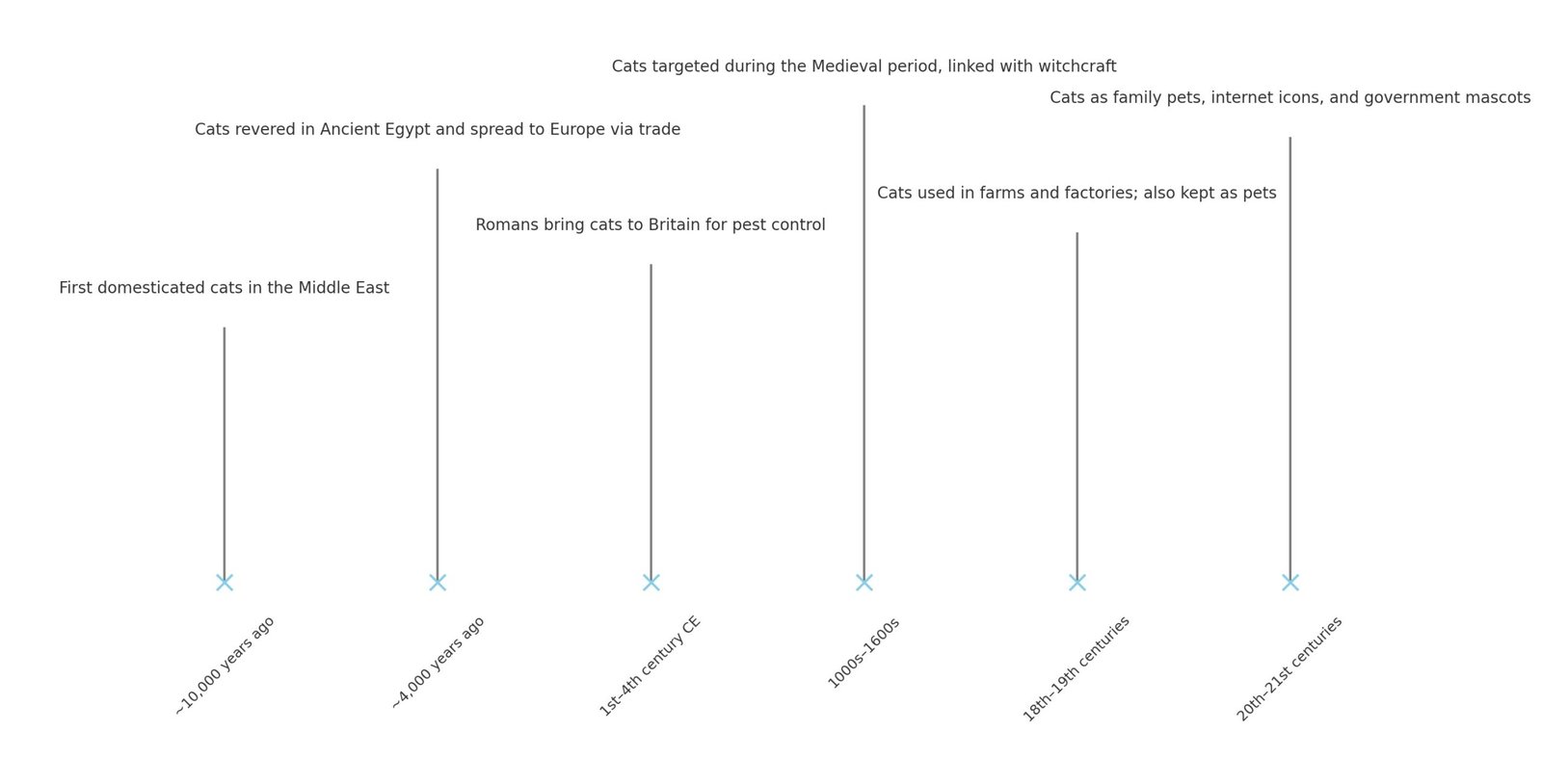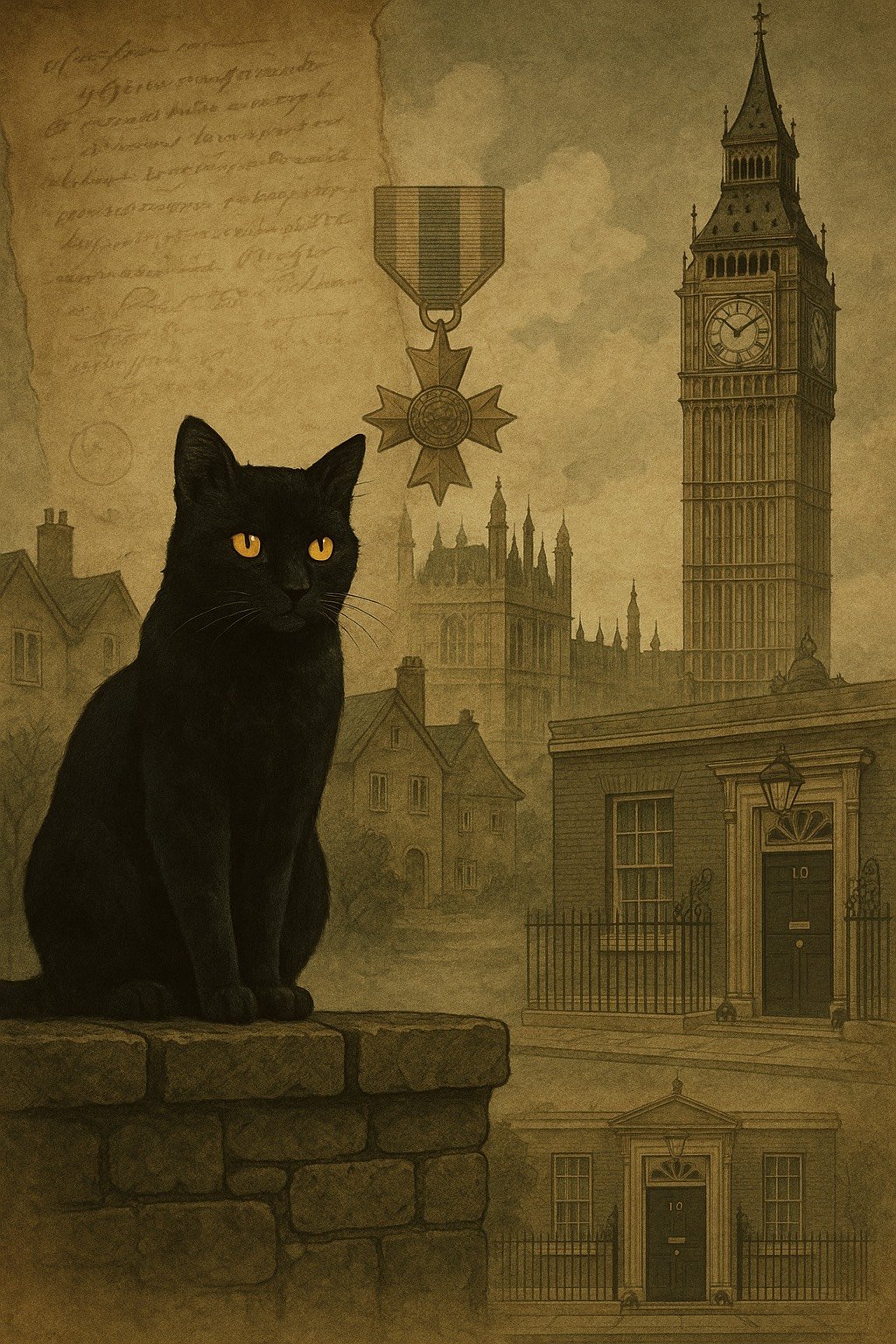Humans and cats have been hanging around together for thousands of years now. Cats have embedded themselves in human society by helping them hunt silently. In the UK it’s been a more dramatic journey for the cats, with religious doubts, military sacrifice, traditional honour and royal adoration.
Let’s uncover the intriguing tale of cats’ evolution from feared to cherished throughout British history.
📜 A Brief Timeline of Cats in British History

- ~10,000 years ago (Middle East): The first domesticated cats appeared in the fertile desert region. These cats are believed to be attracted by the mice which were present in the grain silos. [source: National Geographic].
- ~4,000 years ago (Ancient Egypt): Cats were completely domesticated and regarded as holy animals in ancient Egypt around 400 years ago. Through the invasions, expansions and trade cats finally made it to Europe, predominantly by the traders.
- 1st–4th century CE (Roman Britain): Romans first brought the cats to Britain. Cats were highly regarded for their ability to keep pests out of residences and grain storage facilities. [source: British Museum].
- Medieval period (1000s–1600s): Cats (especially black) were targeted because of skepticism. They were mostly associated with witchcraft.
- 18th–19th centuries (Industrial Revolution): Cats were used in places like farmlands, ships and manufacturing areas to control the vermin. Also the elite and middle classes started keeping them as pets.
- 20th–21st centuries: Cats turned into family pets, online icons, and even the employees of the government such as Chief Mouser i.e. Larry at 10 Downing Street.
🐈⬛ A Shadowy Beginning: Cats and Superstition
Black cats were looked as evil in Britain during the Middle Ages. They were equivalent to witches and ghostly servants to their masters who were doing spying or spellcasting for them. Those ideas which were very popular in continental Europe folktales, gained popularity during the period of social instability and religious paranoia.
A disturbing case preserved in the transcripts from 1566 during a witch trial in Essex, the defendant claimed that her black cat, “Sathan”, was a satanic possession that obeyed her orders. [source: History Today].
Mass cat homicides were alarmingly common because of those fears. Surprisingly, in the 14th century, these kinds of killings did not help during the Black Death, as there were fewer cats left to hunt rats, which contributed to the rise of rats. The rat population skyrocketed, which helped the plague to spread all over towns and cities.
In Scotland it was the total opposite; cats were a good luck sign. The appearance of black cats on your doorstep was to bring prosperity and fortune. As illustrated by these differences, cat folks were never universal across the world.
🐾 “Working Cats of Britain: From Street Strays to Unsung Heroes of History”
As time passed by, practicality was prevailing more than fear. Farmers, merchants, and traders start using the cats for their hunting abilities. Cats were like pest control and they were living mostly by the pubs, grain storages and even homes.
During the Chinese Civil war in 1949, Simon the ship’s cat in HMS Amethyst was very famous. Simon continued to help boost morale of soldiers by catching rats. PDSA awards Simon with the Dickin Medal which is the highest award for animal bravery. [source: PDSA]
Other legendary cats include:
While dogs take most of the credit, cats also have made their impression in British History, from being war time companions to pest controllers to government offices.
🐱 Mrs. Chippy –
During Ernest Shackleton’s 1914 Endurance expedition to Antarctica with carpenter Harry McNish, Mrs Chippy, a tabby, was also present with them. Chippy was a master of balancing in the icy ships even in the high waves. She was euthanized later when the ship was no longer useful. A statue in Wellington, New Zealand, celebrates her legacy till date. [source: Royal Museums Greenwich]
⚓ Tiddles –
Tiddles is probably the most travelled cat who has travelled over 30,000 miles across oceans. Tiddles was very famous and known as a Royal Navy “sea cat”. He was very popular among the sailors and servicemen. Tiddles used to receive fan mail while on his trips. He also had several pictures sitting close to the ship’s wheel. [source: Imperial War Museums].
⛪ Faith – The Wartime Church Cat –
Wartime cat Faith became famous during the Blitz in WWII, by moving her kitten to the basement of the church. When the bombardment got worse she resides at St. Augustine’s Church which is next to St. Paul’s Cathedral. Despite the church taking significant damage, Faith and her kitten survived. So, Faith receives a silver medal by the PDSA for her courage and maternal nature. [source: PDSA Archives]

Fig: Faith
Explore the history of dogs in the UK in From Wolves to Royal Friends: The Wonderful Heritage of Dogs in the United Kingdom
📦 Oscar (a.k.a. Unsinkable Sam) –
Oscar was a survivor who survived three different naval sinking during WWII: HMS Arc Royal, Bismarck the German battleship and HMS Cossack. He then popularly got his nickname as Unsinkable Sam. Oscar was able to get out on each of the occasions and eventually lived in Belfast till the end of his life. Oscar was a symbol of resilience. [source: National Maritime Museum]
🏛️ Larry – The Chief Mouser at No. 10 –
PM office rescues Larry from Battersea Dogs and Cats Home in 2011 and he was the Chief Mouser to the Cabinet Office. He became famous because he was present regularly in press events and other state visits. In addition to handling the rats, Larry had left an imprint on British politics. [source: UK Government Archives]
🏰 Royal Felines: Cats in the British Monarchy
Traditionally dogs held a prominent spot in the royal households, cats were also slowly becoming popular. In the 1800’s Queen Victoria admired Persian cats, which helped cats to be popular in the UK. [source: National Trust UK]
Winston Churchill was also a big fan of cats. Jock, a marmalade cat, has to reside on the estate where Churchill lived at his request. This has been like a custom which is still continues today. [source: Churchill Archives]
Larry the Cat, who is the “Chief Mouser to the Cabinet Office,” since 2011 has outlasted multiple prime ministers at 10 Downing Street.[source: UK Government]
🎭 Cultural Shifts: From Folklore to Fandom
As society was moving forward, superstition receded and affection increased. And cats were also a part of literature, culture, and pop music. T.S. portrayed the cat’s mysterious character. Eliot’s Old Possum’s Book of Practical Cats (1939). That book was later became famous as popular Cats musical.
Beatrix Potter’s Tom Kitten, Lewis Carroll’s Cheshire Cat and various other books gave cats a place in British Literature. In current times, there are many cats in social media with millions of followers. Many videos of the cats go viral and also make a decent amount of money. .
🐾 Conclusion: From Myth to Ministry
The tale of cats in the UK has many ups and downs and comprises so many changes throughout. Cats are in social media, British homes, government offices, where they were once killed labelled as supernatural threats.
From the edges of disgust to the palm of comfort, cats have made their way through wars, epidemics, and superstition. This proves they are fighters, survivors, and valued pets.

